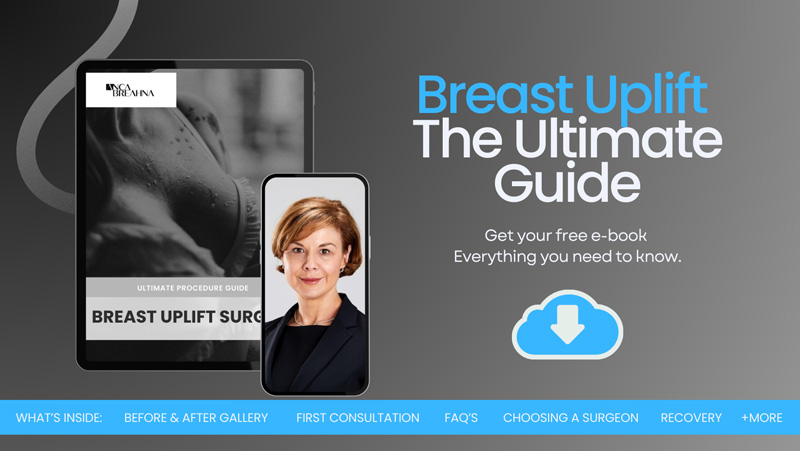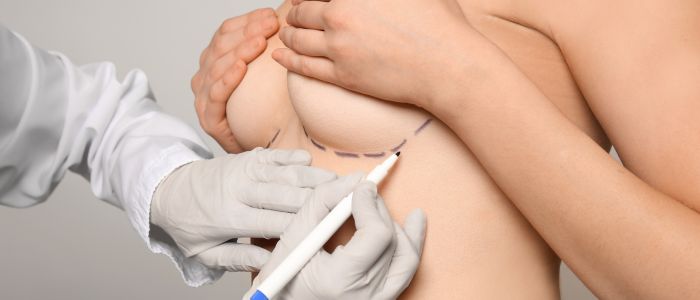
- Treating Lopsided Breasts
- Take our Plastic Surgery Quiz to find out if you'd be a good candidate for cosmetic surgery.
- Causes of Uneven Breasts
- The Psychological Impact of Having Uneven Breasts
- What is Breast Surgery?
- Download Miss Anca Breahna Breast Uplift Guide
- Different Types of Breast Surgery for Uneven Breasts
- The Process of Breast Surgery for Correcting Lopsided Breasts
- Breast Augmentation Before and After Photos
- Recovery and Post-Surgery Care
- Risks and Benefits of Breast Surgery for Uneven Breasts
- FAQs about Solutions for Uneven Breasts
- What causes uneven breasts?
- Are uneven breasts common?
- How can uneven breasts be treated?
- Are there non-surgical solutions for uneven breasts?
- What are the risks associated with surgical treatments for uneven breasts?
- Will insurance cover the cost of treatment for uneven breasts?
- How long is the recovery period after surgery?
- Further Reading about Breast Surgery with Consultant Plastic Surgeon Anca Breahna
- Medical References about Solutions for Uneven Breasts
Treating Lopsided Breasts
You’re here because you’re either curious or concerned about breast asymmetry. And you’re not alone. Many women experience uneven breasts, a condition medically known as breast asymmetry. It’s perfectly normal for one breast to be slightly larger or smaller than the other. For some, the difference may be so slight that it’s barely noticeable. However, for others, the disparity can be substantial and cause emotional distress and self-esteem issues.
Breast asymmetry is a broad term used to describe a variety of conditions where the breasts do not appear identical. This can include differences in size, shape, position, or volume. It’s important to remember that no woman has perfectly symmetrical breasts. A significant difference can become a cause for concern. But don’t worry, help is available, and this blog aims to provide you with a comprehensive understanding of the condition and its potential solutions, particularly breast surgery.
Anca Breahna is known for her dedication and commitment to her field, setting her apart from her peers. She ensures to treat her patients with respect, consideration, and empathy, helping them achieve realistic goals through exceptional care and support. If you are considering a breast procedure, you can book a consultation on the website to learn more and discuss your options with her.
Take our Plastic Surgery Quiz to find out if you’d be a good candidate for cosmetic surgery.
Causes of Uneven Breasts
Before we discuss solutions, let’s first understand the causes behind uneven breasts. Hormonal changes during puberty are the most common cause. As breasts develop, they might not grow at the same rate, which can lead to asymmetry. This asymmetry often evens out over time, but for some, the difference remains even after breast development is complete.
Breast asymmetry can also be caused by trauma, medical conditions, or surgery. Conditions such as juvenile hypertrophy or breast cancer can also affect breast size. In other cases, breast asymmetry may occur following mastectomy or radiation therapy. It’s important to remember that while these causes may sound scary, they are not the norm. Most cases of breast asymmetry are not linked to any underlying medical condition.
However, it’s always a good idea to discuss any concerns with your plastic surgeon. If you’ve noticed a sudden or significant change in your breast size, it’s essential to seek medical advice promptly.
The Psychological Impact of Having Uneven Breasts
The psychological impact of having uneven breasts cannot be understated. For many women, breasts are a significant part of their identity and femininity. Any perceived irregularity can lead to feelings of self-consciousness and low self-esteem. Some women may avoid certain types of clothing or activities due to embarrassment about their uneven breasts, impacting their quality of life.
It’s also not uncommon for women with breast asymmetry to experience anxiety or depression. The societal pressure to conform to certain beauty standards can exacerbate these feelings. However, it’s crucial to remember that you are not alone. Many women experience these feelings, and support is available.
Moreover, it’s essential to understand that everyone’s body is unique, and there’s no such thing as perfect. Embracing your body, in all its uniqueness, is the first step towards self-love and acceptance. But if your uneven breasts are causing significant distress, there are solutions available, including breast surgery.
What is Breast Surgery?
Breast surgery is a broad term that encompasses several procedures aimed at altering the size, shape, or volume of the breasts. In the context of uneven breasts, breast surgery is often used to bring symmetry and balance. This could involve reducing the size of the larger breast, augmenting the smaller one, or a combination of both.
Breast surgery is a significant decision that should not be taken lightly. It involves a surgical procedure, recovery time, and potential risks. For many women, the benefits of achieving breast symmetry far outweigh the potential downsides. It can alleviate self-esteem issues, improve body image, and bring about a renewed sense of confidence.
It’s essential to discuss your expectations and concerns with your plastic surgeon thoroughly. Anca can guide you through the process, outline potential risks and benefits, and help you make an informed decision.
Download Miss Anca Breahna Breast Uplift Guide

Different Types of Breast Surgery for Uneven Breasts
Several types of breast surgery can be used to correct uneven breasts. The choice of procedure depends on your specific needs, the extent of the asymmetry, and your personal preferences.
Breast Augmentation involves using implants to increase the size of the breasts. This is often the choice for women who are also looking to enhance their overall breast size.
Breast Reduction, on the other hand, involves removing excess tissue and skin from the breasts to make them more proportionate. This is often the choice for women who are not comfortable with overly large breasts.
Breast Lift can be used in conjunction with augmentation or reduction to improve the position and shape of the breasts. This is often the choice for women who have sagging breasts due to factors such as age, pregnancy, or weight loss.
The Process of Breast Surgery for Correcting Lopsided Breasts
Breast surgery for correcting lopsided breasts involves several stages. Initially, a thorough consultation with Anca Breahna is necessary to understand your goals and expectations. Anca will conduct a physical examination, discuss your medical history, and explain the different surgical options available to you.
The actual surgery usually takes between one to three hours, depending on the complexity of the procedure. It is usually performed under general anaesthesia, meaning you will be asleep during the operation.
During the surgery, your plastic surgeon will make incisions on your breasts to either insert implants, remove excess tissue, or lift the breasts. The incisions are usually made in inconspicuous areas to minimise visible scarring.
Breast Augmentation Before and After Photos
Recovery and Post-Surgery Care
Post-surgery care is critical to ensuring a successful outcome and a smooth recovery. Immediately after the surgery, you will likely feel sore and tired. You’ll need to arrange for someone to drive you home and stay with you for at least the first night.
Anca will provide you with specific instructions on how to care for your breasts after the surgery. This may include wearing a special supportive bra, taking prescribed medications, and avoiding strenuous activities.
It’s important to note that recovery times vary between individuals. Some may feel back to normal within a week, while others may need a few weeks to recover fully. Regular follow-up appointments with your plastic surgeon are necessary to monitor your progress and address any concerns.
Risks and Benefits of Breast Surgery for Uneven Breasts
Like any surgical procedure, breast surgery for uneven breasts carries potential risks. These can include infection, changes in nipple or breast sensation, scarring, and complications related to anaesthesia. These risks are relatively low, and Anca will discuss them with you in detail before the procedure.
On the other hand, the benefits of breast surgery can be life-changing. Achieving breast symmetry can significantly boost your confidence and self-esteem. It can also expand your wardrobe options and make you feel more comfortable in your body.
FAQs about Solutions for Uneven Breasts
What causes uneven breasts?
- Uneven breasts, also known as breast asymmetry, can be caused by a variety of factors including hormonal changes, genetics, and trauma. It is a common condition and can occur during puberty, pregnancy, or menopause. Other potential causes include uneven muscle mass and underlying health conditions.
Are uneven breasts common?
- Yes, having uneven breasts is quite common. In fact, it is rare to find a person with perfectly symmetrical breasts. The degree of asymmetry can vary greatly from person to person, with some individuals having a noticeable difference in breast size, while others may have a minor difference that is barely noticeable.
How can uneven breasts be treated?
There are several treatment options available for uneven breasts, including:
- Breast augmentation: Using implants of different sizes to increase the size of the breasts
- Breast reduction: Reducing the size of the breasts
- Breast lift: Lifting the breasts to a more symmetrical position
- Fat grafting: Using fat from another part of the body to even out the breasts
Are there non-surgical solutions for uneven breasts?
Yes, there are non-surgical solutions available, including:
- Breast prostheses: Silicone inserts that can be placed in the bra to even out the appearance of the breasts
- Bra padding: Using padding in one side of the bra to create a more balanced appearance
- Physical therapy: In some cases, physical therapy can help address muscle imbalances that contribute to breast asymmetry
What are the risks associated with surgical treatments for uneven breasts?
- Surgical treatments come with risks such as infection, bleeding, scarring, and complications related to anaesthesia. There is also the risk of dissatisfaction with the cosmetic results. It is important to discuss all potential risks with your plastic surgeon before deciding on a surgical solution.
Will insurance cover the cost of treatment for uneven breasts?
- Insurance coverage for the treatment of uneven breasts varies depending on the insurance provider and the specific circumstances of the individual case. In some cases, if the asymmetry is causing physical discomfort or other health issues, insurance may cover part or all of the cost of treatment. It is recommended to consult with your insurance provider to determine coverage.
How long is the recovery period after surgery?
- The recovery period after surgery to correct uneven breasts can vary depending on the specific procedure performed. Generally, it can take several weeks to a few months to fully recover. It is important to follow all post-operative instructions provided by your plastic surgeon to ensure a smooth recovery.
Further Reading about Breast Surgery with Consultant Plastic Surgeon Anca Breahna
- Read more about Breast Uplift with Implants
- Read more about Fat Transfer to Breasts
- Read more about Breast Asymmetry Surgery
- Read more about Natural Boob Job – Autologous Fat Transfer to the Breasts
- Read more about How to Fix Asymmetrical Breasts or Lopsided Breasts – Treatment Options
- Read more about What are Tuberous Breasts and How to Correct Them
Medical References about Solutions for Uneven Breasts
- Breast Asymmetry
- Breast Asymmetry Correction – ASPS
- Asymmetries in Mammography
- Ethnic and age differences in right-left breast asymmetry in a large population-based screening population




 Ms Anca Breahna, PhD, MSc, FEBOPRAS, FRCS (Plast) is a highly regarded Consultant Plastic Surgeon specialising in the field of Aesthetic and Reconstructive Plastic Surgery. Anca performs a range of
Ms Anca Breahna, PhD, MSc, FEBOPRAS, FRCS (Plast) is a highly regarded Consultant Plastic Surgeon specialising in the field of Aesthetic and Reconstructive Plastic Surgery. Anca performs a range of 